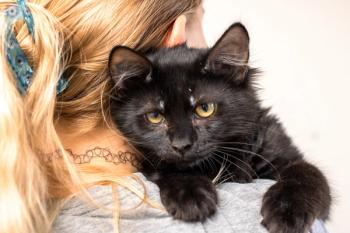
- dvm360 January-February 2025
- Volume 56
- Issue 1
- Pages: 32
Managing dystocia with surgery
Treating the condition requires an understanding of this common reproductive emergency
Dystocia, a difficult or obstructed labor potentially resulting in the inability to expel a fetus, is a common reproductive emergency in dogs and cats. In at least 1 study, the incidence of dystocia in overrepresented breeds such as the Boston terrier, French bulldog, and English bulldog was greater than 80%.1 With the increasing frequency in the French bulldog, dystocia will continue to be a common presentation to first-opinion practices and referral hospitals.
Pathophysiology
Dystocia may occur with maternal or fetal causes. Maternal causes include primary uterine inertia, birth canal obstruction, uterine torsion or prolapse, and vaginal stricture. Fetal causes include malposition, oversize, or fetal death.
Primary uterine inertia is considered the most common cause of dystocia in dogs and cats.2 Underlying causes of primary uterine inertia are debated. Some suggested causes include excessive stretching of the myometrium from a large litter or a very small litter that cannot prompt strong uterine contractions.3 Hypocalcemia and low endogenous oxytocin are also often implicated but still debated.
Clinical signs
Clinical signs may vary based on the underlying cause of the dystocia. If primary uterine inertia is responsible, then very few to no signs of impending parturition may be observed. Clinical signs that may be observed include weak or absent contractions, a prolonged interval between neonates, or strong contractions exceeding 30 minutes without production of the fetus. Four hours is considered the upper limit of the time interval between neonates in canine patients.3 Ultimately, a prolonged gestation, lack of progression from stage 1 to stage 2 labor within a maximum of 24 hours, or a failure to deliver neonates within 36 hours of rectal temperature falling below 100 °F is consistent with a diagnosis of dystocia.3
It can be challenging to differentiate between interruption of parturition and true dystocia in cats. Diagnostics must be performed to assess for fetal distress, malpositioning, or fetalmaternal mismatch to aid in that diagnosis.
Diagnostics
One of the keys to determining the appropriate treatment plan for a patient with dystocia is whether an obstruction is present, as well as screening for evidence of fetal distress. Threeview abdominal radiographs are necessary to count the number of neonates present and screen for an obstruction (Figure). The presence of an obstruction is an absolute contraindication for medical management. A large number of remaining fetuses may also be considered a relative contraindication, given the amount of time that may be required to deliver a large number successfully. Radiographs can correctly determine the number of fetuses in 93% of pregnancies in dogs, whereas ultrasound is correct only 36% of the time.4 Fetal death may also be detected on radiographs and would be an indication for emergency surgery—this may be visualized by evidence of gas associated with a fetus.
Ultrasound is necessary to assess fetal heart rates, an indicator of fetal distress. Fetal heart rates below 180 beats per minute indicate distress and a need for surgery.5 The presence of bowel movements may also be associated with significant fetal distress.5
Point-of-care lab work should also be performed to screen for electrolyte derangements, hypoglycemia, and dehydration. If these are noted, they should be treated accordingly.
Medical management
Criteria that may be identified to support attempting medical management before surgical intervention include a small number of remaining fetuses, fetal heart rate exceeding 150 beats per minute, no evidence of obstruction or fetal abnormalities, and weak or absent contractions—all contributing to a presumptive diagnostic of primary uterine inertia.
If primary uterine inertia is suspected, oxytocin (0.2 U/5 kg) can be administered intramuscularly or subcutaneously every 30 minutes. If a fetus is produced, this can be repeated every 30 to 40 minutes. However, if no fetus is produced after 2 doses, surgical intervention is indicated. Calcium gluconate has been previously recommended for treating dystocia in dogs and cats; however, the evidence behind its use is controversial.
Surgery
The typical surgical intervention for a dystocia case may consist of a cesarean delivery with or without an ovariohysterectomy. To minimize risk to the fetuses, the bitch or queen should be clipped and undergo a dirty prep before any premedication is administered. Additionally, the bitch or queen should be induced in the operating room, ideally with the surgical team already scrubbed and gowned and the instrument table prepared.
The patient is positioned in ventral recumbency, and the abdomen from xiphoid to pubis is prepped and draped. A ventral midline incision is created, beginning a few centimeters cranial to the umbilicus and extending to the pubis. Care must be taken when entering the abdomen as the linea is often stretched and thin because of the gravid uterus. The uterus is carefully exteriorized, taking care with manipulation to reduce iatrogenic injury. A hysterotomy is created over the body of the uterus, and each fetus is removed in a milking fashion along with its associated placenta if possible. Gentle but consistent and firm traction may be recommended to remove the placentas; however, if unable to remove without risking significant hemorrhage, they may be left in situ to pass naturally. If unable to effectively milk the fetuses caudal to the original hysterotomy, it may be extended along the uterine horn on either side to facilitate delivery in a T or Y shape as needed.
Once each fetus is removed, the amniotic sac is ruptured, which is often easiest cranially near the head. The umbilical cord is clamped and transected between 2 hemostats before the fetus is passed off to an assistant with a warm and sterile towel for resuscitation. Ideally, the portion of the umbilical cord left with the fetus is left long if intravenous medications are needed.
The hysterotomy may be closed in a single-layer or double-layer fashion. The author prefers a single-layer closure using appropriately sized monofilament in a simple continuous pattern. The abdomen is lavaged thoroughly and then closed routinely. External. skin sutures should be avoided.
Suppose an ovariohysterectomy is meant to be performed concurrently. In that case, this may either be performed as an en bloc ovariohysterectomy with the entire uterus handed off with fetuses in situ to the resuscitation team, or it may be performed after the cesarean delivery has been completed. It was previously believed that performing an ovariohysterectomy concurrently was associated with a higher complication rate and maternal mortality. However, this has been disproven. If performing an en bloc ovariohysterectomy, the fetuses must be delivered within 60 seconds of clamps being applied to the uterine blood supply.2
Postoperative care
Survival in bitches following cesarean delivery is as high as 99% in some studies and 80% by 7 days postoperatively for puppies.6 Information on survival in cats is limited, but maternal survival is as high as 94% in some studies, with neonatal survival as high as 90%.7,8
Postoperative care should include analgesics, intravenous fluids, and heat support as needed. Pregabalin is a safe and effective oral medication for pain control in postpartum dogs and cats. Ideally, patients are discharged as soon as possible and do not have a prolonged hospitalization due to the risk to the immune-naive neonates.
Owners should be counseled that clear to serosanguineous vaginal discharge can be expected for up to 4 weeks postoperatively in the bitch or queen. They should also be counseled on observing closely for vomiting, diarrhea, and lethargy, as these could be indications of postparturient complications such as metritis, eclampsia, and mastitis.
REFERENCES
- Evans KM, Adams VJ. Proportion of litters of purebred dogs born by caesarean section. J Small Anim Pract. 2010;51(2):113-118. doi:10.1111/j.1748-5827.2009.00902.x
- Fransson B. Ovaries and uterus. In: Veterinary Surgery: Small Animal Expert Consult. 2nd ed. Elsevier; 2011:2109-2129.
- Feldman E, Nelson R. Periparturient diseases. In: Canine and Feline Endocrinology and Reproduction. 3rd ed. Saunders; 2003:808-834.
- Toal RL, Walker MA, Henry GA. A comparison of real-time ultrasound, palpation and radiography in pregnancy detection and litter size determination in the bitch. Vet Radiol. 1986;27(4):102-108. doi:10.1111/j.1740-8261.1986.tb00013.x
- Zone MA, Wanke MM. Diagnosis of canine fetal health by ultrasonography. J Reprod Fertil Suppl. 2001;57:215-219.
- Moon PF, Erb HN, Ludders JW, Gleed RD, Pascoe PJ. Perioperative management and mortality rates of dogs undergoing cesarean section in the United States and Canada. J Am Vet Med Assoc. 1998;213(3):365-369.
- Lambertini C, Ballotta G, Cunto M, et al. Retrospective evaluation of the induction of anaesthesia with alfaxalone or propofol in cats undergoing caesarean section. J Feline Med Surg. 2024;26(11):1098612X241275270. doi:10.1177/1098612X241275270
- Bailin HG, Thomas L, Levy NA. Retrospective evaluation of feline dystocia: clinicopathologic findings and neonatal outcomes in 35 cases (2009-2020). J Feline Med Surg. 2022;24(4):344-350. doi:10.1177/1098612X211024154
Articles in this issue
10 months ago
Toothaches and triumphs10 months ago
Relief practice allows veterinarians to thrive10 months ago
Managing canine oral tumors10 months ago
Understanding anticipatory grief in pet owners10 months ago
Not reinventing the wheel—rethinking it!10 months ago
Power up your dental conversations10 months ago
The economics of dental care11 months ago
Hemoperfusion for acute toxin ingestionabout 1 year ago
Managing canine weight with a diet planNewsletter
From exam room tips to practice management insights, get trusted veterinary news delivered straight to your inbox—subscribe to dvm360.






